
About UsThe Numismatic Bibliomania Society is a non-profit organization promoting numismatic literature. For more information please see our web site at coinbooks.org SubscriptionsThose wishing to become new E-Sylum subscribers (or wishing to Unsubscribe) can go to the following web page link MembershipThere is a membership application available on the web site Membership Application To join, print the application and return it with your check to the address printed on the application. Membership is only $15 to addresses in the U.S., $20 for First Class mail, and $25 elsewhere. For those without web access, write to: David M. Sundman, Secretary/TreasurerNumismatic Bibliomania
Society AsylumFor Asylum mailing address changes and other membership questions, contact David at this email address: dsundman@LittletonCoin.com SubmissionsTo submit items for publication in The E-Sylum, just Reply to this message, or write to the Editor at this address: whomren@coinlibrary.com
BUY THE BOOK BEFORE THE COINYou won't regret it! |
- WAYNE'S WORDS: THE E-SYLUM AUGUST 12, 2012
- REPORT ON THE 2012 PHILADELPHIA CONVENTION NBS MEETINGS
- E-SYLUM WINS NLG AWARD FOR BEST TRADE WEB SITE
- DICK JOHNSON WINS MCA CARL CARLSON CATALOGING AWARD MEDAL
- VINCENT ALONES COLLECTION CATALOG AVAILABLE
- BOOK REVIEW: REEDED EDGE HALF DOLLARS 1836-1839
- REPORTS FROM THE 2012 PHILADELPHIA ANA SHOW
- QUIZ ANSWER: NOAH'S ARK ON COINS
- DAVID DAVIS FAMILY ACCOUNT OF THE SEARCH FOR HIS MISSING COINS
- THE FAMOUS BEALE CIPHERS
- NOTES FROM E-SYLUM READERS: AUGUST 12, 2012
- HAPPY BIRTHDAY, ENCASED POSTAGE STAMPS!
- THE “NACH AMERIKA” TOKENS OF NUREMBERG
- WAYNE'S NUMISMATIC DIARY: AUGUST 12, 2012
- SOME LOTS FROM THE ANA STACKS-BOWERS SALES
- THE SIEGE OF STRASBOURG
- FEATURED WEB PAGE: EXTRA-TERRESTRIAL NICKELS
WAYNE'S WORDS: THE E-SYLUM AUGUST 12, 2012

New subscribers this week include Franky Leeuwerck, Michael Märcher and Harold Kroll. Welcome aboard! We have 1,579 email subscribers, plus 188 followers on Facebook.
This week we open with news from NBS events at this week's ANA convention, some awards issued at the show, an announcement of the catalog of the Vincent Alones Collection, a book review, and more reports from convention attendees on multiple subjects.
Other topics include Noah's Ark on coins, the search for David Davis' missing Bust Dimes, the Nach Amerika jetons, and the siege coins of Strasbourg. To learn more about Vince Alones' mustache, extra-terrestrial nickels, the Beale Ciphers and the Wrong Week to Give Up Sniffing Books, read on. Have a great week, everyone!
Wayne Homren
Editor, The E-Sylum
REPORT ON THE 2012 PHILADELPHIA CONVENTION NBS MEETINGS
NBS events went well at this week's ANA convention in Philadelphia. On Thursday, about 40 people attended our symposium which was a panel discussion about "Auction catalogs from various perspectives" For details, see: www.coinbooks.org/events .
Following that the NBS Board met for its annual business meeting. The board voted to contribute $1000 to the ANA library (as we have done before) and to donate $5000 to the ANS library, a significant increase over our past contributions. This decision was the result of discussing both NBS' strong financial position and current needs in the ANS library. I have been told that it is most likely to help the ANS restore a part-time cataloger position that was at risk. Cataloging, of course, is essential to make acquisitions accessible to library users. If you are ever in New York, I strongly recommend that you plan to visit the ANS and spend time in the library. The great collection and helpful staff makes research there productive and quite fast.
On Friday, the NBS general meeting was also well attended, also by almost 40 people. Treasurer David Sundman reported that our membership increased by about 15 members, helped by articles about NBS written by Brad Karoleff and Joel Orosz in Coin World, and Wayne Homren in The E-Sylum.
We were very pleased to announce winners of this year's NBS awards for articles in The Asylum. James Higby won the "Jack Collins Award for Best New Writer in the Asylum 2011" for his article, "Looks Like I Picked the Wrong Week to Give Up Sniffing Books". Pete Smith won the first "Joel J. Orosz NBS Writer's Award for Best Article in the Asylum" 2011 for his article "Three Degrees of Dave Bowers".
Kerry Wetterstrom of The Celator and Steve Roach of Coin World discussed the challenges and future of numismatic publishing. It was quite intriguing to hear the similarities (and a few differences) between the running of a quarterly publication for a smaller somewhat more specialized audience and running a weekly/monthly publication with a larger audience.
We then concluded the meeting with an auction of about two dozen donated lots which raised $3420. This auction is a big part of why NBS remains financially strong every year and can keep dues low while also being able to support two important numismatic libraries. This is made possible by the donors (Dan Hamelberg, Pierre Fricke, Whitman Publishing, George Kolbe, Dennis Tucker, and myself), buyers, and those people who are sometimes overlooked but are crucial to any auction: the underbidders.
NBS also had information and membership applications at the American Numismatic Society's table. I personally signed up a new member (well, a lapsed member returning to the fold) and, hopefully, our outreach will produce a few more members from this year's ANA convention. Unfortunately, I never actually got to the one exhibit in the numismatic literature class so I'll have to leave that to another attendee to describe.
I encourage all members to consider exhibiting literature at the ANA or regional conventions as well as writing for the Asylum. Please get in touch with me or any board member or David Yoon, our editor if you are considering writing an article and have any questions.
... the brown bag lot George Kolbe dropped off which went for $900 and the hotly contested Lincoln VanDerBlatt tome that went for $1100.
Perhaps some of the attendees can fill us in on the details next week. -Editor
E-SYLUM WINS NLG AWARD FOR BEST TRADE WEB SITE
 Wow! We won an award at the American Numismatic Association convention in Philadelphia this week. When I talked to Joel Orosz on the phone he said "I'm sure you've already heard the news through your vast network of stoolies and snitches, but..."
Wow! We won an award at the American Numismatic Association convention in Philadelphia this week. When I talked to Joel Orosz on the phone he said "I'm sure you've already heard the news through your vast network of stoolies and snitches, but..."
And in fact I had - David Schenkman and David Sundman forwarded photos of the plaque issued by the Numismatic Literary Guild (NLG) naming The E-Sylum the Best Trade Press Web Site.
It's a great honor, especially considering the level of competition out there. We're just a spare-time one-man show, but of course what really drives our success is the participation of our readers, who comprise some of the best numismatists in the world. There's no numismatic topic too common or too obscure to touch on, and we can count on getting authoritative answers to tough questions, and some great numismatic stories, all while having a little bit of fun each week. Thanks!

 To learn more about the
Numismatic Literary Guild (NLG) - not to be confused with our organization, the Numismatic Bibliomania Society (NBS), see:
www.nlgonline.org
To learn more about the
Numismatic Literary Guild (NLG) - not to be confused with our organization, the Numismatic Bibliomania Society (NBS), see:
www.nlgonline.org
DICK JOHNSON WINS MCA CARL CARLSON CATALOGING AWARD MEDAL
 The Medal Collectors of America awarded D. Wayne Johnson (our frequent writer "Dick Johnson") their Carl Carlson Medal Thursday, August 9 at the Philadelphia ANA convention. It is awarded annually for cataloging medals in the numismatic field.
The Medal Collectors of America awarded D. Wayne Johnson (our frequent writer "Dick Johnson") their Carl Carlson Medal Thursday, August 9 at the Philadelphia ANA convention. It is awarded annually for cataloging medals in the numismatic field.
The medal, formerly cast as an organizational medal, was created by medallist Alex Shagin. It was made into a 2 1/2-inch (64mm) die recently; this is the first struck piece from that die. It was customized by date 2012 inscribed on the obverse and the name of the medal and the recipient's name on the reverse.
Dick did not have time to send a close-up photo of the medal, but had an oil painting sent showing him holding the medal.
VINCENT ALONES COLLECTION CATALOG AVAILABLE
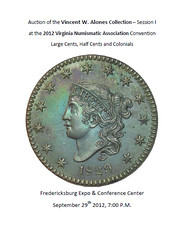 Vincent W. Alones was born August 23, 1916 to Lithuanian immigrants, in Long Island City, NY. Vince grew up in New York and graduated in 1934 from Sewanaka High School in Floral Park, NY. He joined the U.S. Navy after Pearl Harbor and served more than 4 years in the Naval Guard and then aboard a PT boat in the Philippines. After the war he resumed working for the Long Island Railroad, married Agnes Rose Jeckewicz, started his family, and together they became pillars in their community of Floral Park Centre as well as nationally prominent members of the numismatic community.
Vincent W. Alones was born August 23, 1916 to Lithuanian immigrants, in Long Island City, NY. Vince grew up in New York and graduated in 1934 from Sewanaka High School in Floral Park, NY. He joined the U.S. Navy after Pearl Harbor and served more than 4 years in the Naval Guard and then aboard a PT boat in the Philippines. After the war he resumed working for the Long Island Railroad, married Agnes Rose Jeckewicz, started his family, and together they became pillars in their community of Floral Park Centre as well as nationally prominent members of the numismatic community.
Agnes was born in Wilkes-Barre, PA, Feb. 5, 1924 to Lithuanian parents. The oldest of nine siblings, she helped raise them as the family moved back and forth between Wilkes-Barre and Detroit, Michigan. During WWII, she worked in Detroit factories making tanks and airplanes, a real life “Rosie the Riveter.”
Vince starting coin collecting in 1926 and continued all his life. His interests and scholarship were wide and varied and he shared them generously. Vince won over 200 prizes in numismatic competitions, became an American Numismatic Association (ANA) judge, and trained and certified judges. Vince served as assistant general chairman at the ANA's 1976 Convention in NYC. He won an ANA Presidential Award and the Medal of Merit. Agnes and Vince became Numismatic News – “Numismatic Ambassadors” in 1975. He joined more than 30 organizations of the collecting hobbies as well as veterans support organizations with Agnes. He was a 50 year member of the local volunteer Fire Department.
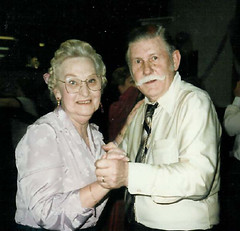 Vince's accomplishments were supported every step of the way by Agnes who supplied energy, humor and encouragement to all their friends and activities. They were especially proud of the Young Numismatists programs they helped initiate. They rarely missed an ANA convention since 1952, traveling extensively throughout the lower 48 states to attend and enjoying the opportunity to reconnect with old friends who shared their passion for collecting.
Vince's accomplishments were supported every step of the way by Agnes who supplied energy, humor and encouragement to all their friends and activities. They were especially proud of the Young Numismatists programs they helped initiate. They rarely missed an ANA convention since 1952, traveling extensively throughout the lower 48 states to attend and enjoying the opportunity to reconnect with old friends who shared their passion for collecting.
In 2008, Vince left Floral Park and moved to Lynchburg to be with Agnes. He quickly joined the Lynchburg Coin Club and connected with the Lynchburg veteran's community. His enthusiasm for numismatics remained undiminished until the end. Vincent William Alones, 95, died at his home in Lynchburg, Virginia, Feb. 1, 2012, on the 64th anniversary of his marriage to Agnes Rose Jeckewicz, who died October 16, 2009. He is survived by his daughter, Vinessa Alones and son-in-law Jim Fraley of Lynchburg and son, Vincent P. Alionis and his wife, Mary of Grants Pass, Oregon. Grandchildren are AJ and Eric Fraley and Zosha and Kazimer Alionis.
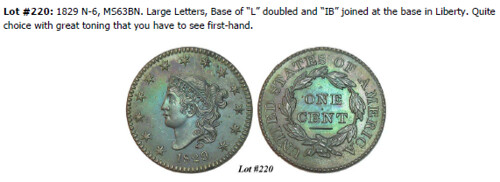
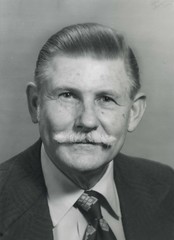
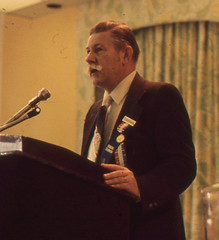
To read the earlier E-Sylum articles, see:
VINCENT W. ALONES, 1916 - 2012
(www.coinbooks.org/esylum_v15n22a08.html)
MORE ON VINCENT W. ALONES
(www.coinbooks.org/esylum_v15n23a09.html)
BOOK REVIEW: REEDED EDGE HALF DOLLARS 1836-1839
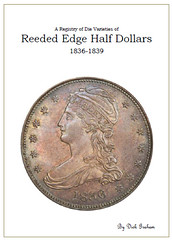 The JRCS meeting took place on Wednesday morning and Dick Graham gave the presentation based on his long awaited and just published new reference book on the Reeded Edge Half Dollars of 1836 to 1839. This series records the dramatic changes undergoing at the Mint, from the adoption of the long dreamed steam operated coining press, to the opening of the first branch mint for silver coinage (New Orleans).
The JRCS meeting took place on Wednesday morning and Dick Graham gave the presentation based on his long awaited and just published new reference book on the Reeded Edge Half Dollars of 1836 to 1839. This series records the dramatic changes undergoing at the Mint, from the adoption of the long dreamed steam operated coining press, to the opening of the first branch mint for silver coinage (New Orleans).
Further changes include Gobrecht's gradual introduction of his new Seated Liberty design, which was delayed in the half dollars until 1839.
Meanwhile, the half dollar was such an important monetary coin (in fact half dollars were the backbone of most banking and economic transactions during this period) that production had to continue. Dies were prepared from hubs, with only the final digit added in by hand to record the current year. Finishing touches to the dies were also done by hand to strengthen various design elements when needed.
Dick Graham's long awaited book is a welcome addition to any advanced library and now the information on particular die pairings is available to any collector, as well as their rarity ratings.
To read the earlier E-Sylum article, see: NEW BOOK: REEDED EDGE HALF DOLLARS 1836-1839 (www.coinbooks.org/esylum_v15n32a04.html)
REPORTS FROM THE 2012 PHILADELPHIA ANA SHOW
Pete Smith writes:
Just a single exhibit was shown in the Numismatic Literature class at the Philadelphia ANA. P. Scott Rubin presented "American Numismatic Literature of the 1850's. Included were four publications from the decade of the 1850's.
Paul Hybert writes:
A version of the Exhibit guide is available at www.chicagocoinclub.org/events/2012/ana/ex/all.by.cl.html but this needs a few little touchups (removing the sections for the three classes in which no exhibits were entered, for instance). Also, the awards are not yet entered.
Alan V. Weinberg writes:
I had approached the Philadelphia ANA with trepidation after seeing and hearing and sensing the economic fear and "hands in the pockets" atmosphere of recent shows .
Well, all I can say is the hobby is alive and well and dealers and collectors attended with great enthusiasm and an open wallet. The atmosphere was one of excitement and anticipation. I did not hear any negative or even mediocre comments.
StacksBowers had a literally "standing room only" Battle Born collection auction session of Carson City coins. I acquired the unique Mexican War entirely hand -engraved gold medal in the Rarities Night session. If nothing else happened, that was enough to place me on cloud nine.
There was a healthy attendance of overseas dealers and the variety of items for sale on the bourse floor was akin to a candy shop for kids. Like last year's Chicago ANA, the bourse was so large I just could not see every booth.
Numismatics is alive and well.
Unpublished Gold Mexican War Award Medal
Voted by New York State in January 1849 Presented to General Ward B. Burnett, August 20, 1853
Unmarked, but probably struck from coin gold, .900 fine. Integral jump ring at 12 o'clock, fancy hanger in the shape of a vertical figure-eight with a hand-engraved and decorated belt charm attached. Entirely hand-engraved with designs imitative of the earlier medal authorized by the Common Council of the City of New York, designed by C.C. Wright. Legends unique to this medal, on obverse CHERUBUSCO, CHAPULTEPEC, VERA CRUZ, CERRO GORDO, CONTRERAS. GARITA DE BELIN. around the periphery, 1846-48 below the central device of America heaving a thunderbolt into Vera Cruz.
On the reverse, the periphery reads: "Presented by the New York Volunteers, To Bv't Brig. Gen. Ward B. Burnett." around the seal of the City of New York. Beautifully engraved in banknote-style intaglio on flat fields surrounded by a high square raised rim. Unlike the struck medals presented by the City of New York in 1848, this piece does not bear the signature of C.C. Wright, leading us to assume that it was not engraved by him like the dies for its earlier predecessor. Needless to say, whomever engraved this was a very competent engraver, likely based in New York City.
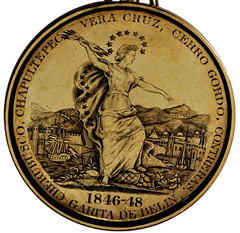
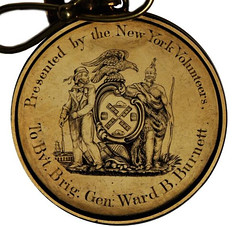
Gold Mexican War Award Medal
Presented to General Ward B. Burnett
To view the complete lot description, see: stacksbowers.com/Auctions/AuctionLot.aspx?LotID=370154
Alan adds:
One exasperating aspect of the ANA was the joint ANS/ANA exhibit. Last year 's exhibit error was repeated again this year. Incredible rarities were exhibited in vertical -standing wood and glass cases. The coins were standing upright on little plastic easels. The lighting came from small fluorescent lighting two feet or so directly above the coins.
Now common sense and a quick visual look will tell you that all you will see is a round dark shadow of a coin exhibited in this manner and even if you bend down below the coin on bent legs you can barely make out the coin's design. It was so obvious that the proper and effective way to exhibit the coins was to lay them down flat on the glass and let the light expose the entire coin's surface rather than hit the top rims of the coin and create a dark shadow.
THE BOOK BAZARRE
QUIZ ANSWER: NOAH'S ARK ON COINS
 Last week I asked if Noah's Ark had the subject of a coin before Armenia's new 2012 500 Dram coin. I figured the answer was an easy "yes", and now E-Sylum readers had identified several examples for us. These would make a nice adjunct to any Coins of the Bible collection. Thanks, everyone!
-Editor
Last week I asked if Noah's Ark had the subject of a coin before Armenia's new 2012 500 Dram coin. I figured the answer was an easy "yes", and now E-Sylum readers had identified several examples for us. These would make a nice adjunct to any Coins of the Bible collection. Thanks, everyone!
-Editor
Leon Saryan writes:
Noah's Ark appears on virtually every coin issued by the Republic of Armenia from 1994 to date. If the Republic's redesigned coat of arms is present on the coin, the Ark appears in the center of the shield resting upon the taller of the two peaks of Mt. Ararat.
Yossi Dotan writes:
All coins of Armenia, including the one depicted by you, feature the nation's coat-of-arms on the obverse. Its shield shows Mount Ararat. A short line on the top of the mountain represents the Ark.
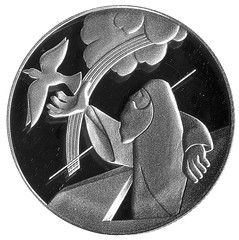 Israel issued three coins in 5758 (1998 C.E.) that depict Noah in the Ark, stretching out his hand from the window to release a dove—1 new sheqel (KM-316), 2 new sheqalim (KM-317), and 10 new sheqalim (KM-319).
Israel issued three coins in 5758 (1998 C.E.) that depict Noah in the Ark, stretching out his hand from the window to release a dove—1 new sheqel (KM-316), 2 new sheqalim (KM-317), and 10 new sheqalim (KM-319).
Niue issued a 1/33-dollar coin in 2010 (KM-481). The reverse depicts the Genesis story of the Flood as shown on the Sistine Chapel vault in the Vatican. The vault shows the Ark. The coin may have it as well.
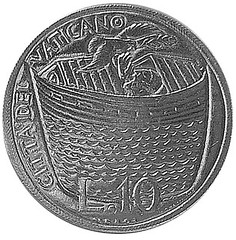 Vatican City's 10 lire 1975 (Y-127) features Noah in the Ark looking at the dove returning to the Ark with a fresh olive leaf in its beak. The 20 euro 2002 (Y-361) depicts violent men and animals against the background of the Ark, prior to the Flood.
Vatican City's 10 lire 1975 (Y-127) features Noah in the Ark looking at the dove returning to the Ark with a fresh olive leaf in its beak. The 20 euro 2002 (Y-361) depicts violent men and animals against the background of the Ark, prior to the Flood.
There is also a ducat of the city of Regensburg in Germany of 1649 (Fr.-2469a).
Of course, there may be many more.
Jay Galst writes:
The first coin with the depiction of Noah's ark was the Roman Provincial issue from Apamea in Phrygia 217-18 AD. Macrinus was the emperor on the obverse of this specimen.
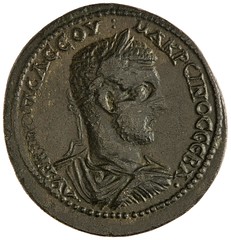
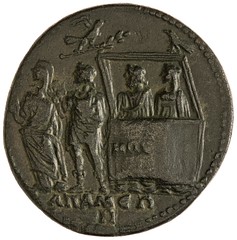
This coin was displayed in the 2007 Exhibit: PICTURING THE BIBLE, THE EARLIEST CHRISTIAN ART, at the Kimball Art Museum in Ft Worth, Texas.
It was also in the 2008 Exhibit: ONE HUNDRED YEARS OF SOLICITUDE - COLLECTING BY THE NEW YORK NUMISMATIC CLUB, at the ANS in New York City. This was in the inaugural exhibit in the new location of the ANS.
To read the earlier E-Sylum article, see: NOTES FROM E-SYLUM READERS: AUGUST 5, 2012: Armenia's New Noah's Ark Coin (www.coinbooks.org/esylum_v15n33a08.html)
DAVID DAVIS FAMILY ACCOUNT OF THE SEARCH FOR HIS MISSING COINS
Phil Carrigan wrote in the August 12 JR Newsletter:
Today I shared with my wife Mary Clare part of John McCloskey's article on the Davis Bust Dime Collection. The part I read from John's neat article concerned the 63 missing dimes which Janet Davis couldn't locate. Her approach to invite family members to do a complete search resulted in finding the coins. The coins were found well hidden in a place no burglar would have found. What was Mary Clare's response? Where was the hiding place? I am now committed to asking John for this bit of key information!
Well, on Wednesday web site visitor Ellen Waara wrote:
I enjoyed reading your article last night, the night that David Davis' coins were auctioned at ANA. Attached is the article that I (his daughter of 42 years) wrote about the search and find of the 63 missing coins.

Saturday was a stellar day at the Davis house. Uncle Darby was visiting from Pittsburgh. Josh celebrated his 17th birthday with five friends. It was 46 degrees, and there was talk afoot of renting a metal detector.
David’s rarest dimes, one of a kinds featured in the book he’d authored with three other numismatists, were missing. Last we’d heard, he’d hidden them somewhere upstairs, before his last ANA coin convention in New York. That was over a year ago, and he didn’t remember where. Now he was gone. The guy who always had the answer to my every question wasn’t there to ask.
Still, I pestered him anyway. I’d ask the sky when we’d walk (he prefers mornings, I like dusk).
-- Where are they, David? Now that you can go anywhere, find ‘em please.
-- Don’t worry, they’re in the computer room. It’s taken care of, he’d reply.-- Okay, I’d say, you’re in charge. I’ll have to admit, my faith faltered.
John McCloskey, the executor of the coins, said that the auction houses weren’t as interested in incomplete collections. The rarest ones were gone, and that would depreciate the remaining collection to about 70 percent of the Coin World attributed value.
-- I know, I know, Mom would sigh in frustration as I read aloud each email from John, repeating requests for renewed searching.-- Don’t shoot the messenger, I’d say with relief (she snaps when I nag).
The upstairs rooms under the eaves, and above the garage were David’s domain. Like a lion in his cave, he polished part to perfection: the FROG (fourth room over the garage) was lined with antique bankers bookcases filled with priceless catalogues (to someone, we weren’t entirely sure who). The other side of the hall hoarded empty boxes, tons of paperwork, and unspecified volumes of “stuff”. The task of sorting, peering beneath floor joyces, and rooting through hidden eaves was daunting to say the least.
Saturday, Uncle Darby and I strategized on the phone. He’d been thinking about getting a metal detector.
Mom had given up on the project:
--“Are you sure he didn’t already sell them for medical bills?” she kept wondering aloud.
-- No Mom, John would know if he’d sold them, I assured her again.
Josh was preoccupied with whatever a 17 year old boy thinks about (do we even want to know?)
I went off to breakfast with Jan, planning to scout resale for a Flora dress, for my Tennessee Williams lead in the play this weekend. Despite warm weather, my spirits were in a slump.
After breakfast I’d noticed the phone had rung, twice. The line was busy (everyone has call waiting these days, I thought impatiently).
When I called Josh’s cell, he answered (miracle - he only takes texts). His party was fine, and they’d found the coins!
They were stashed behind the computer room bookcase where I’d stood staring for five minutes when last I’d visited. A box was wedged in behind.
Still, John consulted via phone, the oldest ones were missing. Only two existed: he had discovered one, David had the other. I had a flash back to four remote authors meeting in a hotel room central to New York, Ohio and Michigan for 24 hour marathon writing sessions. (Today the signed deluxe copies of their books are collector’s items).
Once Josh was shown how plain and worthless the pirated booty looked, he remembered another box in the loft and scampered up the narrow stairs. --They’ve been there the whole time, I didn’t think they were worth anything. They just looked old, he explained.
He asked for a 10 percent cut. Darby suggested a vacation. Mom sounded cheerful for the first time in awhile. It was no mystery, David was taking care of her still.
All that day, I could feel my celebrating clan surrounding me, walking with Jan and me as we stretched our legs on the PollyAnna trail.
--Was this an old railroad bed, Jan asked?
--Oh yes, I explained, they go all across the state (David had taught me that).
Grandma Davis (David's mom who died last July) was there as we looked for dresses at the resale shop.
--My Grandma was the Costumier at Toledo University, I bragged. She’ll help me find the right attire.
Aunt Paula (deceased for a decade) was there as we giggled and did girly things. Uncle Smokey and Aunt Madonna were there as I walked into the Pix Theatre for play practice. I got the idea as Aunt Mary and Uncle Al flashed into my mind that this had been a family treasure hunt.
Russ Logan (one of the deceased co-authors) entered my mind from left stage, he had been a part of the great re-discovery. The veils between the dimensions of living and everlasting Soul-dom were leaky that day.
Of course I’ll never know quite how they did it. I suspect that when three or more souls are gathered, there Am I (as Jesus taught manifesting). We call it Master Minding.
I think that even if you are out of your mind (as in no longer in a body) you use the greatest power of love, and focused intention to influence and guide. Dozens of fluttering wings watching over us as we meander, get lost, and remember our way while learning life lessons.
--Take a picture, I insisted. I was to see my Pirate Family with their Booty!
Mostly I want to record this moment of connectivity, a family reunion, to remind us on those days when the veils between here and there are more solid. When I get small, alone, and sad, it will be a good picture to have.
To read the earlier E-Sylum article, see: "HONEY, I HID THE COIN COLLECTION!" (www.coinbooks.org/esylum_v15n26a15.html)
THE FAMOUS BEALE CIPHERS
 If you see someone digging with a shovel under the moonlight in Bedford County, Virginia, chances are you've come across a treasure hunter. For more than a century, hopeful treasure seekers have combed these green hills, searching in vain for a fantastic treasure said to have been buried here, as described in a mysterious coded document.
If you see someone digging with a shovel under the moonlight in Bedford County, Virginia, chances are you've come across a treasure hunter. For more than a century, hopeful treasure seekers have combed these green hills, searching in vain for a fantastic treasure said to have been buried here, as described in a mysterious coded document.
The story goes that a man named Thomas Beale discovered a fabulous wealth of gold and silver in 1818 in what is now Colorado, and along with his company of thirty partners, brought it back to the east and buried it in Virginia. Beale wrote three encoded letters: one giving the exact location of the treasure, a second giving its detailed description, and a third giving the names and contact information of the thirty partners. Only one of the letters — the second describing more than four tons of gold, silver, and jewels — was ever deciphered. It has tempted the greedy and adventurous ever since.
The world first learned of the Beale ciphers in 1885 with the limited publication of a pamphlet in Lynchburg, Virginia entitled The Beale Papers: Containing Authenticated Statements Regarding the Treasure Buried in 1819 and 1821, Near Bufords, in Bedford County, Virginia, and Which Has Never Been Recovered.
To read the complete article, see: The Beale Ciphers (skeptoid.com/episodes/4301)
In 1885, a pamphlet was published supposedly telling where to find millions of dollars in gold and silver. The instructions were encrypted. The pamphlet told the story of Thomas Jefferson Beale, who made a fortune out west, and buried it in Bedford County, Virginia. Three separate messages were encrypted in the pamphlet, and consist of pages of numbers, separated by commas. The writer of the pamphlet gave the solution to the second message:
I have deposited in the county of Bedford, about four miles from Buford's, in an excavation or vault, six feet below the surface of the ground, the following articles, belonging jointly to the parties whose names are given in number "3," herewith:
The first deposit consisted of one thousand and fourteen pounds of gold, and three thousand eight hundred and twelve pounds of silver, deposited November, 1819. The second was made December, 1821, and consisted of nineteen hundred and seven pounds of gold, and twelve hundred and eighty-eight pounds of silver; also jewels, obtained in St. Louis in exchange for silver to save transportation, and valued at $13,000.
The above is securely packed in iron pots, with iron covers. The vault is roughly lined with stone, and the vessels rest on solid stone, and are covered with others. Paper number "1" describes the exact locality of the vault, so that no difficulty will be had in finding it.
The key to decrypting this second message is the Declaration of Independence. Every number in the message refers to the first letter of a word in the Declaration of Independence. A 115, for example, would mean the first letter of the 115th word. The third message is relatively uninteresting to treasure hunters, as it tells who the treasure belongs to. Apparently, no one has ever decrypted the first or third messages.
To read the complete article, see: The Famous Beale Cipher (www.jimloy.com/puzz/beale.htm)
THE BOOK BAZARRE
NOTES FROM E-SYLUM READERS: AUGUST 12, 2012
Comments on Hugh Sconyers
Regarding last week's mention of Hugh Sconyers and the 1982 rare coin market,
Martin Kaplan writes:
I wonder whatever happened to the amazing coins he bought? Recycled by now? I would think a few of the collectors/investors he was buying for might still have some of the coins...
To read the earlier E-Sylum article, see: HUGH SCONYERS AND THE 1982 RARE COIN MARKET (www.coinbooks.org/esylum_v15n33a19.html)
Corrections to the August 5, 2012 Issue
Last week I wrote: " Hugh Sconyers and his invertors...". Of course, this should have been INVESTORS. Thanks to Bill Eckberg for reporting this.
I mangled this sentence, too: " I conformed this with Chopmark News editor Colin Gullberg...", to which Bill responds:
I firmly affirm that you formed your sentence in an infirm manner by failing to conform to proper formal English usage.
Opps! Sorry - we'll fix these in our archive.
To read the earlier E-Sylum articles, see:
NOTES FROM E-SYLUM READERS: AUGUST 5, 2012: Chopmark Collectors Club Dues
(www.coinbooks.org/esylum_v15n33a08.html)
HUGH SCONYERS AND THE 1982 RARE COIN MARKET
(www.coinbooks.org/esylum_v15n33a19.html)
I MENTION a certain writer in an e-mail, and the reply comes back: “Comcast McCarthy??? Phoner novelist???” Did I really type “Comcast”? No. The great god Autocorrect has struck again.
It is an impish god. I try retyping the name on a different device. This time the letters reshuffle themselves into “Format McCarthy.” Welcome to the club, Format. Meet the Danish astronomer Touchpad Brahe and the Franco-American actress Natalie Portmanteau.
In the past, we were responsible for our own typographical errors. Now Autocorrect has taken charge. This is no small matter. It is a step in our evolution — the grafting of silicon into our formerly carbon-based species, in the name of collective intelligence. Or unintelligence as the case may be.
Earlier this year, the police in Hall County, Ga., locked down the West Hall schools for two hours after someone received a text message saying, “gunman be at west hall today.” The texter had typed “gunna,” but Autocorrect had a better idea.
One more thing to worry about: the better Autocorrect gets, the more we will come to rely on it. It’s happening already. People who yesterday unlearned arithmetic will soon forget how to spell. One by one we are outsourcing our mental functions to the global prosthetic brain.
I can live with that. We do it with memory, we do it with navigation, so what the he’ll, let’s do it with spelling.
To read the complete article, see: Auto Crrect Ths! (www.nytimes.com/2012/08/05/opinion/sunday/auto-correct-this.html?_r=1)
HAPPY BIRTHDAY, ENCASED POSTAGE STAMPS!
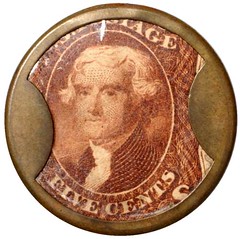

An S. Steinfeld 5 cent Encased Postage Stamp
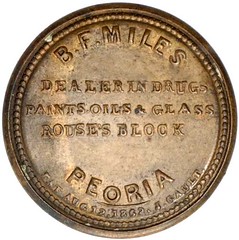 B.F. Miles 1 cent Encased Postage Stamp
B.F. Miles 1 cent Encased Postage Stamp
I made this close-up of the Steinfeld for those who may have missed it. The patent date of August 12, 1862 is at the bottom of the merchant side.
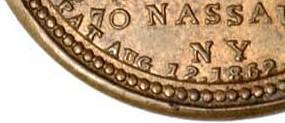
THE “NACH AMERIKA” TOKENS OF NUREMBERG
C. Wyllys Betts in his famous 1894 book, American Colonial History Illustrated by Contemporary Medals, looked far and wide for examples of American colonial history shown in medals, tokens and even lead seals. His studies led him to not only American produced medals and tokens, but those of Britain, France, Netherlands, The Holy Roman Empire, Scandanavia, Germany and Spain, as well as the American colonies of those European powers.
However, he neglected to turn his attention to the City of Nuremberg in South Germany. If he had, he might have discovered some of the most remarkable of the colonial-themed tokens, the “NACH AMERIKA” jetons of the period 1774-1777 by guildmaster Johann Georg Kunstmann.
The first jeton bears a typical crudely engraved bust of Louis XVI on the obverse, the second, a slightly more elegant bust of Elizabetha of Russia with the legend “ELISA – BATHA”. On the reverse of both is a sailing ship heading left (west) and is clearly from the same reverse die. Again, this is a very non-descript and very common style used by multiple masters of the time. Both are tiny – 19.5 mm and .97 gr. But what makes these two types very different than any of the tens of thousands of different known Nuremberg jeton types is the reverse legend above the ship – “.NACH . AMERIKA” – “To America.”
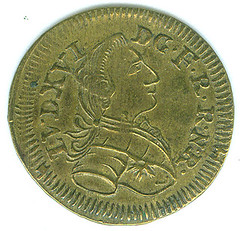
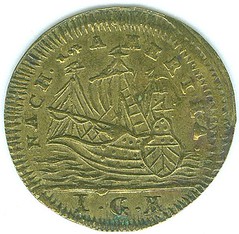
Kunstmann’s Louis XVI “NACH . AMERIKA” Jeton
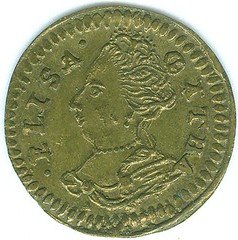

Kunstmann’s ELISA – BATHA “NACH . AMERIKA” Jetonhoto # 6 ob
- President’s Message (Jim Rosen)
- Captain Thomas Machin and the Last Connecticut and Vermont Coppers (Christopher R. McDowell)
- The “Nach Amerika” Tokens of Nuremberg – A Little Known, Betts-Related Token from the Colonial Days (Robert Levinson)
- 2012 – Second Quarter Colonial Auction Recap (Michael Wierzba)
- An Unusual, Thought-Provoking Find in Keeseville, NY – 2008 (Norman G. Peters)
- New Jersey Copper Possibly Overstruck on a French One Sol of John Law (John Lorenzo)
- ANA’s Summer Seminar – June 23 to 29, 2012 (Ray Williams)
- America’s Foreign Coins (Dick August)
- Honorials and Memorials Funds
- In Memorium – Don Anderson (William Gleckler)
- C4 Library News (Leo Shane)
- Announcements
- Classified Ads
WAYNE'S NUMISMATIC DIARY: AUGUST 12, 2012
On Wednesday August 8 a couple items in Garrison Keillor's Writer's Almanac caught my eye and ear - each had a faint numismatic connection.
Britain's "Great Train Robbery"
Britain's "Great Train Robbery" was carried out on this date in 1963. In the pre-dawn hours, a Royal Mail train bound from Glasgow to London was stopped by an unexpected red signal on the line. When the conductor stopped the train to investigate, 15 men in ski masks, armed with iron bars, boarded the train and relieved it of 124 sacks of bank notes worth well over £2 million.
The robbers made a getaway to their farmhouse lair about 30 miles away, where they counted and divided the money and even played Monopoly with it. They cleaned the place before they left, but didn't do a very thorough job, and police were able to recover the fingerprints of all of the robbers.
The Submarine H.L. Hunley
There is a small numismatic connection to this event, which we've discussed before in The E-Sylum:
On this date in 2000, the submarine H.L. Hunley was raised from the bottom of Charleston Harbor, where it had lain since February of 1864. The Hunley was about 40 feet long and four feet in diameter. It was made of cast and wrought iron, and it was propelled through the water by the means of a hand-cranked propeller. The sub was designed for a crew of eight: seven men to turn the propeller crank and one to steer. It had two small, watertight hatches and two ballast tanks, which could be filled with water or pumped dry, depending on whether the sub needed to dive or surface. As soon as it was successfully tested, the Confederate Army seized it for the war effort.
The sub — also called a "torpedo fish" — set out on its first and last mission of the Civil War in February 1864. The Union warship Housatonic was guarding the entrance to Charleston Harbor when the Hunley embedded a barbed torpedo in the Union ship's hull. The bomb detonated as the sub made its retreat, sinking the warship and making the Hunley the world's first successful combat submarine. The crew gave the "mission accomplished" signal to Confederate forces on the shore, and began to make their way back to port. But the Hunley never arrived.
Author Clive Cussler spearheaded the 15-year effort to find and recover the Hunley. A diver finally found the wreck in 1995, about 100 yards from the wreck of the Housatonic. The submarine was buried in silt, which had kept it preserved and hidden for more than a hundred years.
So what's the numismatic connection? The famous "lucky coin" carried by the sub's commander:
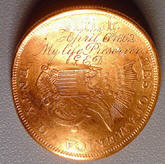 Lt. George Dixon, the sub's commander, carried with him a special $20 gold piece. "Early in the war, in Mobile, Ala., Queenie Bennett (Dixon’s fiancée) gave him a $20 gold piece. While at Shiloh, a Union bullet penetrated his trouser pocket and struck the coin. The impact left the gold piece shaped like a bell, with the bullet embedded in it. If it wasn’t for that coin, he probably would have died on the battlefield–and the Hunley might never have made history. He would carry that coin the rest of his life..."
Lt. George Dixon, the sub's commander, carried with him a special $20 gold piece. "Early in the war, in Mobile, Ala., Queenie Bennett (Dixon’s fiancée) gave him a $20 gold piece. While at Shiloh, a Union bullet penetrated his trouser pocket and struck the coin. The impact left the gold piece shaped like a bell, with the bullet embedded in it. If it wasn’t for that coin, he probably would have died on the battlefield–and the Hunley might never have made history. He would carry that coin the rest of his life..."
To read an earlier E-Sylum article, see: UPDATE ON THE HUNLEY, THE LUCKY COIN SUBMARINE (www.coinbooks.org/esylum_v13n32a16.html)
To read the Writer's Almanac for August 8, 2012, see:
In the Moment
(www.elabs7.com/functions/message_view.html?
mid=1540510&mlid=499&siteid=20130&uid=0ce7fb4f1a)
SOME LOTS FROM THE ANA STACKS-BOWERS SALES
Lot 4095: Reverse Splasher of Libertas Americana Medal
This piece was previously published in the December 1957 issue of The Numismatist as part of George Fuld's work on medallic memorials to the Marquis de Lafayette. It was lost for decades before turning up in our 2010 auction and now reappears as part of this magnificent collection of Comitia Americana medals and cliches. This piece would have likely been given by Dupre to Franklin, and thence to one of Franklin's friends in France, or from Dupre to another historic figure in Paris circa 1783. The marbled paper, similar to paper Franklin is known to have used at his press in Passy, provides another potential link to Franklin himself.

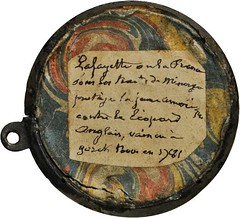
To view the complete lot description, see: http://stacksbowers.com/Auctions/AuctionLot.aspx?LotID=373120
Lot 7262: American Bank Note Company Presentation Book
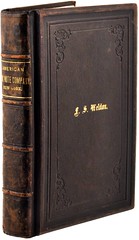 This Latin American style presentation book for use with those clients or by a salesmen working in that region. The article and first 30 plates are all Latin American. Many of the vignettes used on Mexican Bancos and other rare South America notes. Many of the earlier vignettes that follow had cross-over uses to the Latin American series and could have been used on securities and other item engraved and printed by the ABN. The opening intaglio plate with Bolivar center and larger than Lincoln and Grant flanking (note he was President of the United States in 1869) is a homage to patriot and his reverence in America for expelling the Spanish monarchists from governmental authority. Historically a significant volume in the big picture and of course important in the genre of security printing history.
This Latin American style presentation book for use with those clients or by a salesmen working in that region. The article and first 30 plates are all Latin American. Many of the vignettes used on Mexican Bancos and other rare South America notes. Many of the earlier vignettes that follow had cross-over uses to the Latin American series and could have been used on securities and other item engraved and printed by the ABN. The opening intaglio plate with Bolivar center and larger than Lincoln and Grant flanking (note he was President of the United States in 1869) is a homage to patriot and his reverence in America for expelling the Spanish monarchists from governmental authority. Historically a significant volume in the big picture and of course important in the genre of security printing history.
To view the complete lot description, see: stacksbowers.com/Auctions/AuctionLot.aspx?LotID=367264
Lot 7588: 1862 $50 Legal Tender Note.
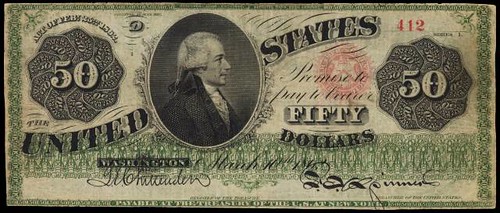
To view the complete lot description, see: stacksbowers.com/Auctions/AuctionLot.aspx?LotID=367590

THE SIEGE OF STRASBOURG
The city of Strasbourg was a very good place for Protestants. The citizens were staunchly Lutheran-minded and the city was a member of the Schmalkaldic League. The growth in Protestantism was welcomed by the city, as it immediately employed armed force to drive the Catholic portion of the cathedral chapter out of the city – at the time, Bishop Johann IV and his Catholic cathedral chapters were based in Saverne, the Protestant cathedral chapter in Strasbourg.
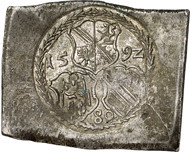
Johann Georg of Brandenburg. Uniface Thaler Klippe of 80 Kreutzers, 1593
The conflict intensified greatly in 1592 when the old bishop died and both parties elected a successor. The Protestant successor was 15-year-old Johann Georg of Brandenburg, and for the Catholic successor, Karl of Lorraine.
Armed conflicts quickly followed. At the beginning of 1592, the Catholic army surrounded Strasbourg and besieged the city. This is also the time that our little series of siege klippes was created.
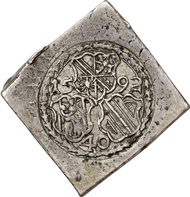
Johann Georg of Brandenburg. Uniface Quarter-Thaler Klippe of 20 Kreutzers
As with most siege coins, these are very simply manufactured. The stamping is uniface only and depicts three coats of arms: on top, that of Bishop Johann Georg of Brandenburg, below it left, the shield of the cathedral chapter, and right, the shield of the city of Strasbourg. On the top, the cipher of year is inscribed, and below, the value numeral. There are three weight variations: the pieces of a thaler of 80 kreutzers, the half-thaler pieces of 40 kreutzers and the extremely rare klippe of a quarter-thaler, or 20 kreutzers.
I asked our resident siege coin expert Larry Korchnak about these, and he adds:
Both coins are reasonably rare. The smaller - half taler - piece is much rarer than the large one - 92 kr.
To read the complete article, see: The Siege of Strasbourg (www.coinsweekly.com/en/The-Siege-of-Strasbourg/8?&id=212&type=a)
FEATURED WEB PAGE: EXTRA-TERRESTRIAL NICKELS
This week's Featured Web Page was mentioned in CoinUpdate on Thursday, August 9th - a gallery of Hobo Nickels featuring depictions of extra-terrestrials. Be sure to click on the link and see all the images. Neat!Did you ever wonder what our currency might look like if aliens invaded our planet and for some strange reason decided to integrate into our culture rather than destroying us all? This selection of extra terrestrial coins includes some of the most intriguing hobo nickels on Earth. If you’re not familiar, hobo nickels are any coin-not just nickels- of which the original carvings have been altered.

www.visualnews.com/2012/08/07/hobo-nickles/
